Squares Arsenal | Hunchback | Dogana | Colleoni | Rioba | Piazzetta St. Mark | Stefano | Rialto Vecchio
The Hunchback or Gobbo of the Rialto and the Column of Proclamations
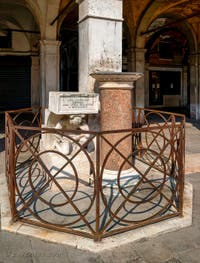
Hunchback Gobbo of Rialto Close by the fish market or the fruit and vegetables on the Rialto, a stone's throw from the magnificent frescoes of the Ramo o Parangon, is the Hunchback of the Rialto or Il Gobbo di Rialto as it's known here in Venice.
In a corner of the pretty Campo du Rialto, in the heart of the Fabbriche Vecchie, is our Gobbo, opposite the church of San Giacomo di Rialto, or San Giacometo to those in the know!
The Hunchback of the Rialto is in fact just a poor man destined to carry on his back, for the rest of his life, a staircase leading to the top of a porphyry column known as the Proclamations.
The Column of Proclamations
On this porphyry column were proclaimed by the “Comandador”, the laws and public announcements of the Republic of Venice.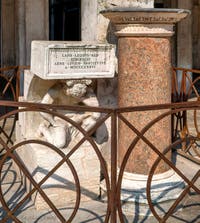
Hunchback Gobbo of Rialto But our hunchback is far from representative of his name.
He's more of an athlete, or even an Atlantean according to some, and there's no back deformity to characterise him.
He owes his title of Gobbo simply to his posture, kneeling and stooping under the weight of the staircase and the heavy marble slab resting on his head.
Imagination and Venetian wit did the rest, and so this Hercules became the Hunchback or Il Gobbo di Rialto.
This statue, its staircase and its porphyry column were installed on the Campo du Rialto in 1541.
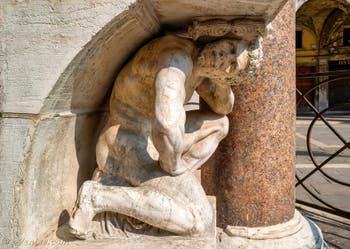
The Hunchback or Gobbo of the Rialto Some believe that the porphyry column was brought back from Saint John of Acre in 1291. However, we have not been able to verify this claim.
The statue and staircase of the Hunchback of the Rialto, meanwhile, were made in 1541, by the sculptor Pietro Grazioli da Salò.
But staying out in the open for several centuries, and being stepped on to boot... meant that in 1836, the Hunchback of the Rialto was the subject of a restoration.
In addition, and to better protect him, he was then encircled by the low wrought-iron grille that you can still see around him.
Embraced by the condemned!

Hunchback Gobbo of Rialto Thieves and other thieves who had just been condemned by the Venetian Republic, had to walk, under the booing of the Venetians, a route that started at St. Mark's and ended at the Rialto.
Once they reached Rialto, their ordeal was not over. They were whipped.
After this first humiliation and punishment, they were exposed to the pillory.
At the time, the men's pillory was located on the Campo de San Zaccaria, while the women's pillory was on the Campo de Santa Maria Formosa.
A very Venetian custom took hold after the installation of the Hunchback of the Rialto in 1541. Convicted criminals were asked to kiss the stone Hunchback as a sign of repentance.
But the Church did not much appreciate this custom, which, although Venetian, was above all very pagan!
The Lion and Cross of the Rialto Whips
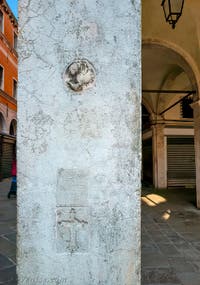
Lion and Cross of Rialto Whippers Also, On March 13, 1545, on the column of the portico behind the Gobbo, which today stands at number 100 on the Campo San Giacomo in Rialto, was placed an engraved stone bearing a cross and a St. Mark, appropriately represented by a lion.
From then on, the condemned began to kiss the cross as a sign of repentance for their sins, and everyone was happy, including the hunchback!
The lion and the cross, like the poor athlete carrying the staircase, were immediately baptised by the Venetians with the name “Fouettés” (dei Frustai), the punishment that awaited the condemned when they arrived at the Campo del Rialto.
The lion of the whipped was unfortunately badly damaged in 1871, the year in which it lost most of its head while the rest of its body was almost torn from the bottom of the stone medallion. Unfortunately, vandalism is nothing new...
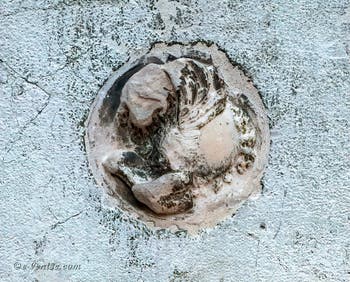
The Lion of the Rialto Whips It is interesting to note, however, that this lion is rather peculiar and unusual in its depiction of the Lion of St. Mark.
First of all, it wears what could be described as a wig or, more probably, a bonnet on its head and back.
And this “thing” which covers his back (and probably also covered part of his head) is also of a particularly large size compared to the rest of the lion's body.
This “lion cover” is something that we have not found elsewhere in Venice in the many representations of the Lion of St. Mark that are to be found there.
Another element is also troubling.
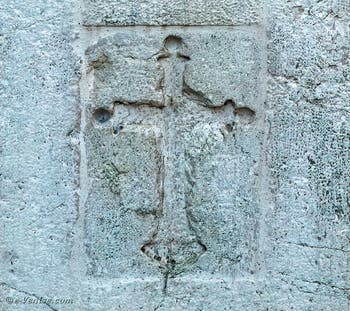
The Cross of the Rialto Whippers The lion of St. Mark is most often depicted with the Gospel and the inscription “Pax tibi Marce, Evangelista meus” (Peace be with you, Mark my Evangelist) posed upright and under one of its paws.
Here the Gospel is laid flat and the lion has its two paws placed across its pages...
Certainly the same type of paw position can be found on the Gospel of the column of the Piazzetta of St. Mark, but there the explanation is simple.
The St. Mark lion there was in fact originally an Asian chimera brought to Venice and “cobbled together” with wings and whose paws obviously did not originally have the orthodox, classical position of the St. Mark lion.
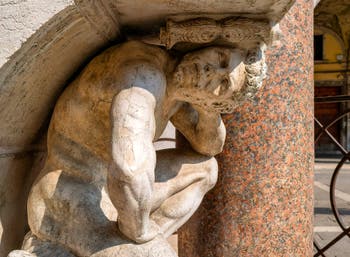
The Hunchback or Gobbo of the Rialto So if there are any of you specialists who can explain the rather unusual attitude of this whipped, hooded lion of the Rialto, we'd be happy to incorporate your explanation here!
As for the cross of the whipped, it is more traditional and is positioned about fifty centimetres below the lion of the whipped. You can imagine the poor condemned men kissing it...
The Hunchback of the Rialto: A Grotesque character who even began to write
Hunchbacks, in 1500, were generally laughed at by the people as they often symbolised a certain derision for them.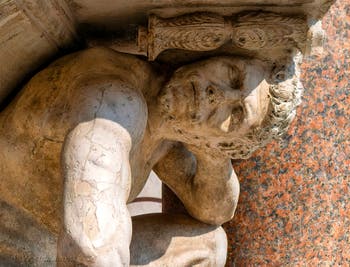
The Hunchback or Gobbo of the Rialto So that's also what happened to the Gobbo du Rialto.
As a result, the hunchback of the Rialto also became a place where Venetians hung notes and criticism against the church and the Republic of Venice, we would say today on the Internet, a forum!
But the high point of the Hunchback's satire and derision was the year 1577, when a pamphlet was written by Cigogna: “Il Gobbo di Rialto a Pasquino”.
The Hunchback of the Rialto was then, by convention, a satirical and grotesque character, just like Pasquino, the Pasquin and the Marforio of Rome.
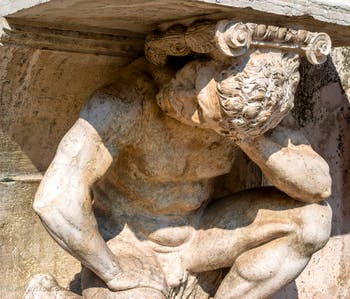
The Hunchback or Gobbo of the Rialto Our Hunchback of the Rialto, under the pen of Cigogna, came to life and wrote a pamphlet under his name, the real subject of which was the prohibitions of the time, to his counterpart the Marocco of St. Mark, one of the figures represented on the columns of St. Mark and who wears melons.
The choice of these two figures was obviously not neutral since it was from St. Mark's that the condemned departed before arriving at Rialto to be flogged.
As you will see when you visit the Hunchback of the Rialto, this poor man, who has carried his staircase for five centuries without flinching, was more than just a column of proclamations, thanks to the Venetian humour and verve that are still very much alive today: here we like to laugh!
Squares Arsenal | Hunchback | Dogana | Colleoni | Rioba | Piazzetta St. Mark | Stefano | Rialto Vecchio
Back to Top of Page

